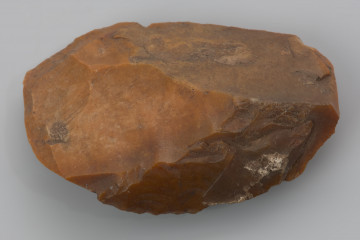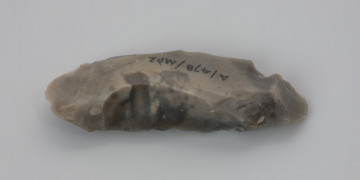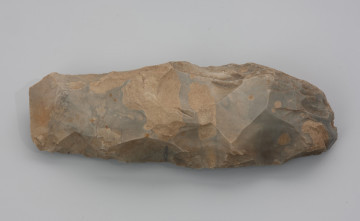
Flake axe
9600 p.n.e. — 4100 p.n.e.
National Museum in Szczecin
Part of the collection: Stone Age
A half-finished core axe was found at Czarne Lake in Kołowo, the Gryfino district, probably in 1913. It is an object made of high-quality chalk flint from a large lump with a strongly worn natural surface and cracks, which indicate that it was extracted from a river or stream with a swift current. The primary technique used was to strike it with a hard (stone) pestle. Due to its form, the half-produced axe from Kołowo can easily be mistaken for the half-finished Neolithic axe. In the early stages of production, Mesolithic axes and Neolithic axes, the so-called four-sided axes, may appear similar, but there is a significant difference between them. Axes were usually planned from the outset as quadrangular tools with right angles between the faces and consistent rebounding of the splinters from the four edges at the sides, which greatly facilitated the formation of the tool. Earlier, axes were in most cases planned in the early stages of production as lenticular tools, i.e., with one omnidirectional edge from which the splinters were chipped off alternately to both sides. It sometimes resulted in an apparent tetrahedrality, as in the case of the presented axe. It is usually the result of using a lump of flint with a near-circular cross-section, which Mesolithic makers tried to flatten already in the first stages of tool production. Interestingly, the axe from Kołów was recognised as the so-called eolith, collecting which was quite popular at the turn of the 19th and 20th centuries. Such tools were then associated with the oldest stages of European settlement. Today we know that most of them are entirely natural fragments of flint, created, for example, by bruising lumps of flint in streams, on seashores or destroyed by glaciers. Others, however, such as the half-formed axe from Kołowo, are younger than once assumed.
Michał Adamczyk
Author / creator
Dimensions
cały obiekt: height: 17.7 cm, width: 5.7 cm
Object type
semi-finished product, axe (mesolithic tool)
Technique
carving, hard masher carving
Material
flint, stone
Origin / acquisition method
acquisition
Creation time / dating
Creation / finding place
Owner
National Museum in Szczecin
Identification number
Location / status

9600 p.n.e. — 4100 p.n.e.
National Museum in Szczecin

9600 p.n.e. — 5400 p.n.e.
National Museum in Szczecin

7000 p.n.e. — 4100 p.n.e.
National Museum in Szczecin
DISCOVER this TOPIC
National Museum in Lublin
DISCOVER this PATH
Educational path